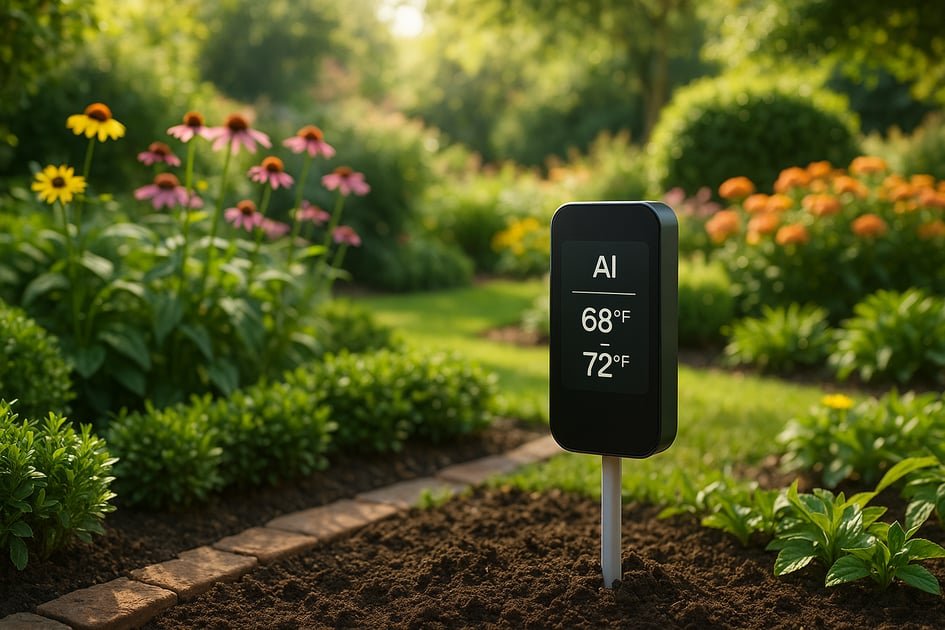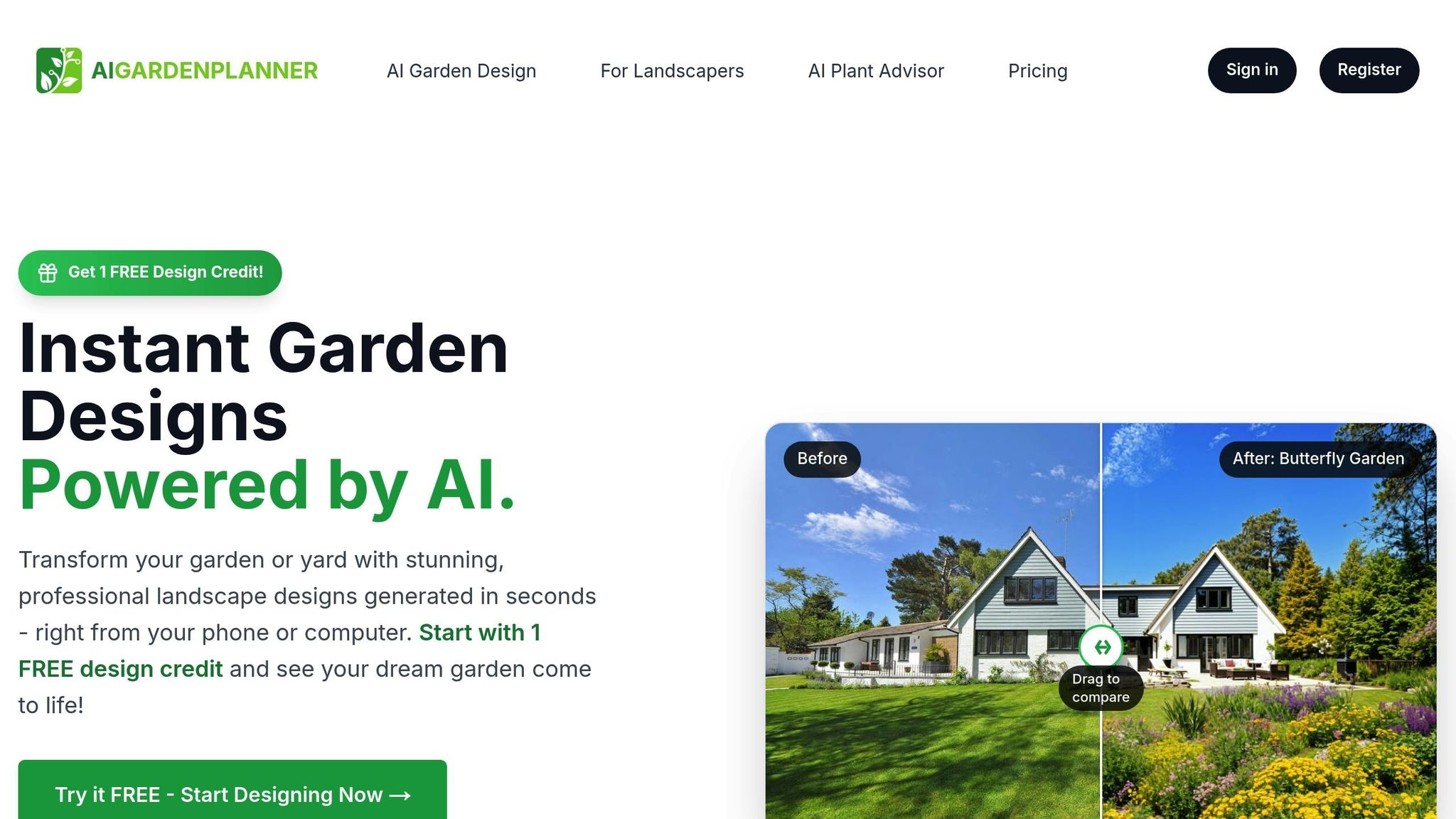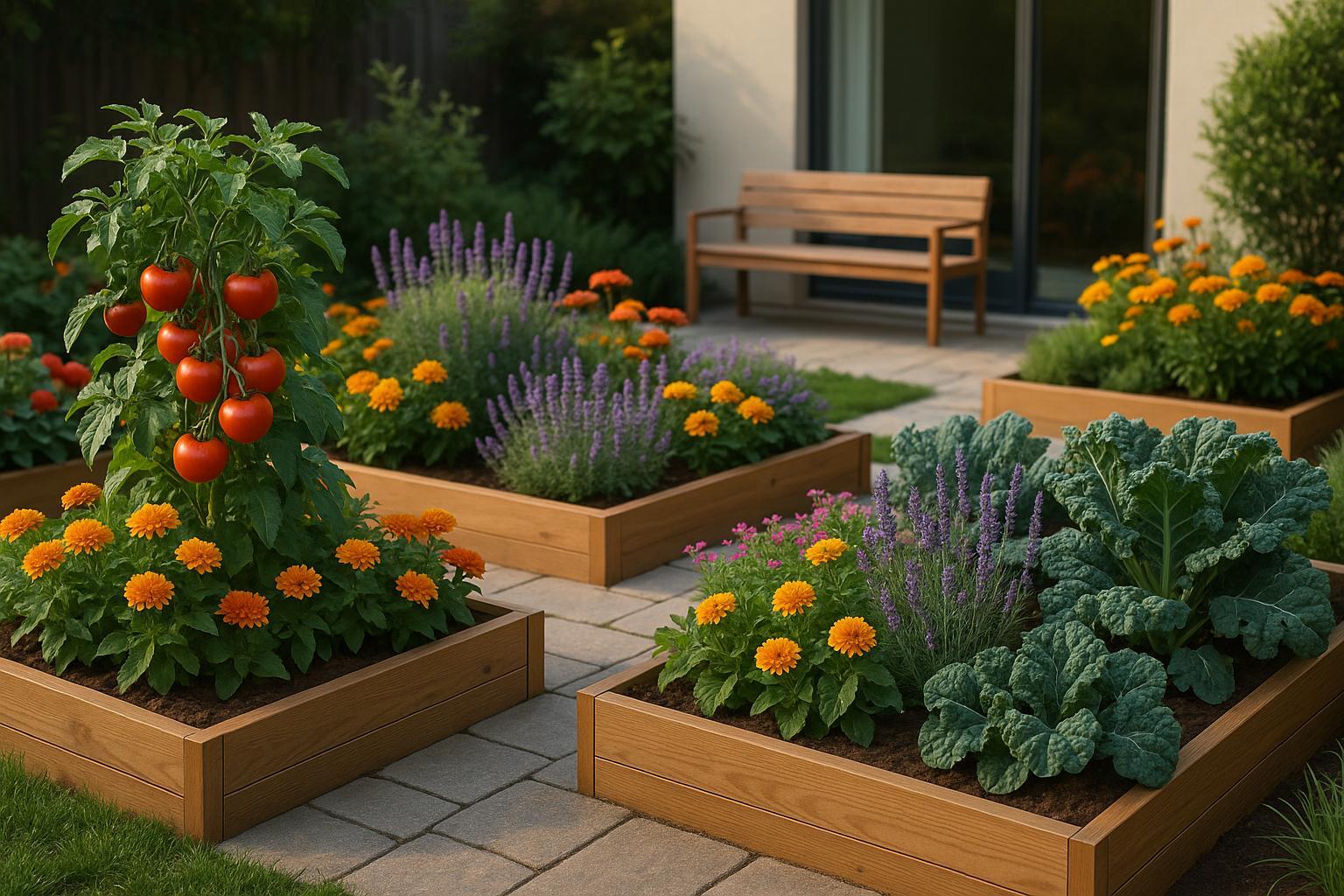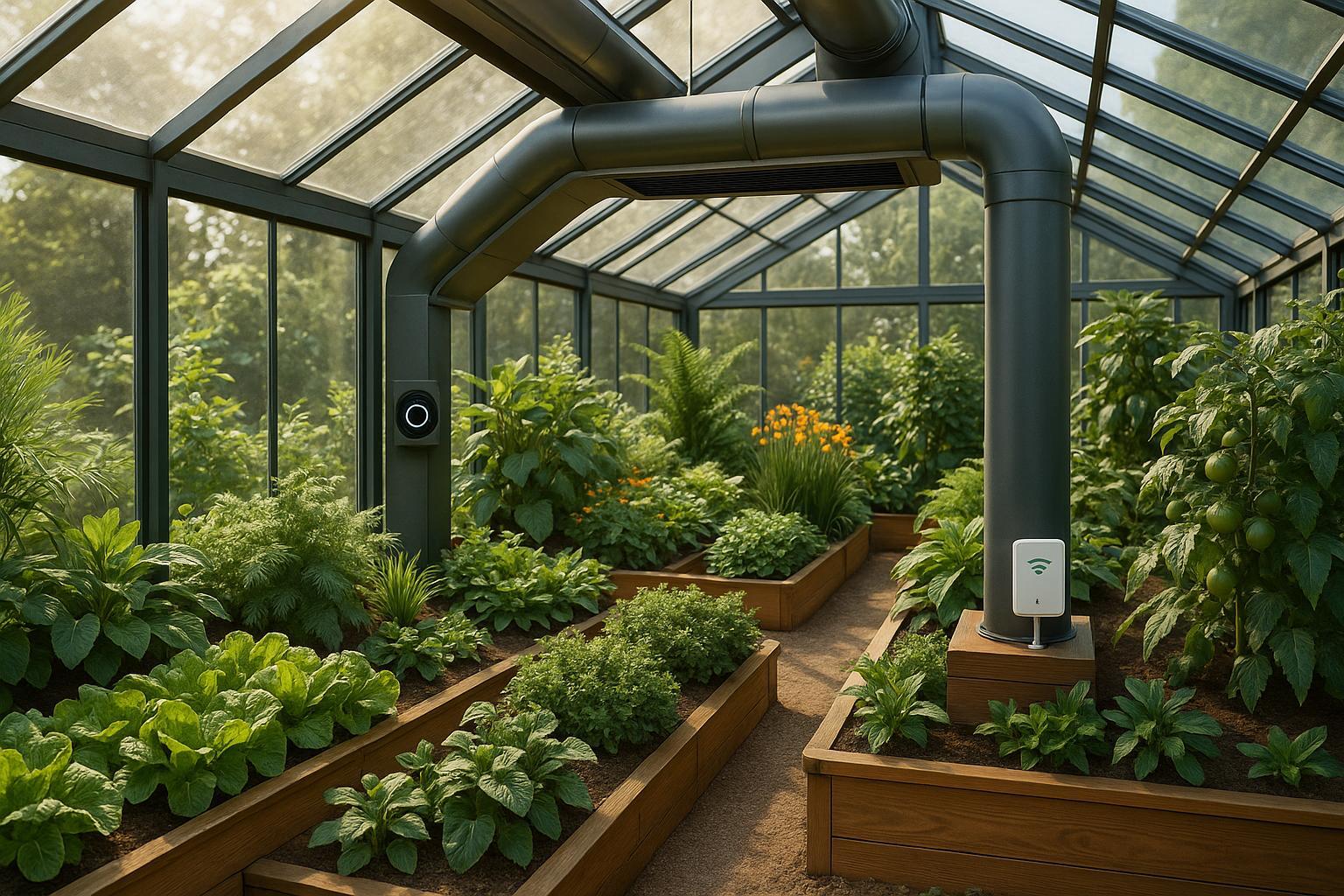How AI Regulates Garden Temperatures Automatically

AI-powered systems simplify garden temperature control by using sensors and real-time data to maintain ideal conditions for plants. These systems adjust heating, cooling, shading, and watering based on current weather, garden microclimates, and forecasts. Unlike manual methods, which can be time-consuming and reactive, AI ensures consistent temperatures, improves plant health, and reduces energy and water usage. Here's how it works:
- Real-Time Monitoring: Sensors track temperature, humidity, and sunlight across your garden 24/7.
- Automatic Adjustments: AI activates misters, fans, or heaters before conditions harm plants.
- Zone-Specific Care: Different parts of the garden get tailored treatments based on their unique needs.
- Weather Forecast Integration: AI prepares for heatwaves or cold snaps in advance.
- Energy Efficiency: Systems target only areas that need cooling or heating, lowering costs.
Big Issues with Heat and Cold in Gardens
Heat and Cold Harm
Big shifts in heat can mess up garden plants. When it gets too hot, you might see plants with curled leaves, flowers that fall too soon, or plants that stop growing. Leafy greens may start to bolt when it's too hot, which spoils their taste. On the other side, a quick frost or big changes from day to night can hurt soft plants, sometimes in ways you can't fix.
Even without wild weather, small heat changes in a spot can make taking care of a garden hard.
Spots with Different Heat
Gardens get natural microclimates - small spots with their own heat traits. For example, spots in full sun, near things like patios or driveways, tend to get and stay hot, creating warm spots. But, places in the shade from trees or buildings can be much cooler, even if they're close by.
Wind ways and the stuff used in the garden count too. Things like walls or wind guards can keep heat, making some spots warmer when it's cold. But, open spots can get cold or hot fast based on how much sun they get. Even using dark mulch or raised beds can make these heat changes bigger.
Why It's Hard to Keep Track by Hand
With these quick and odd changes, just checking the heat now and then doesn't work well. Fast shifts in microclimates can slip by, leaving plants at risk. This is where machines help - they watch all the time and keep conditions even, giving a better way to look after garden heat without the hard work of guessing.
Bloomiee | AI Gardening Control System w/ Camera & Sensors

How AI Helps Keep Garden Warm or Cool
AI garden tools link up a bunch of sensors, switches, and coolers to keep garden heat just right without help. They learn from what happens in the garden and change based on what they see and weather reports.
Watching and Fixing Right Away
AI for keeping heat starts with sensors all over the garden that don’t use wires. They check important things like heat, wet air, and sun, and send what they find to a main switch. Unlike old heat checks that wait to hit a high to change, AI looks at patterns and fixes things before they go wrong.
For example, if it gets hotter, the AI might turn on water sprays, make more shade, or push more air around. It can handle many things at once, making sure each part of the garden stays just right. This way of doing things stops heat problems before they start.
Looking Ahead at Weather
AI doesn’t just look at now, it tries to see what’s coming. It connects to weather sites and uses smart guessing to get ready for changes in heat. It looks at weather now and in the past to guess what will happen next.
For instance, if it's going to get really hot soon, it might cool the ground early and make more shade in spots that need it. Or if it’s going to get cold, it might warm the ground or cover some plants. This way of thinking ahead keeps plants safe and changes how the garden keeps its heat right as the seasons switch, with no big surprises.
Hand-On vs. AI Heat Keeping
Here's a table that shows how AI does better than doing it by hand:
| Aspect | Manual Control | AI Control |
|---|---|---|
| Checking How Often | Checks now and then | All the time, right away |
| How Fast to React | Slow, can be late | Changes fast |
| Seeing Weather Ahead | Uses weather news from outside | Makes and uses its own weather news |
| Using Power Well | May use too much or too little air | Uses the right amount of energy |
| Work Needed | Needs a lot of checks | Hardly any work once set up |
| Keeping Temperature | Can go up and down | Keeps it the same all the time |
| Cost Over Time | Might cost more in bills | Cuts down energy and water costs |
The good things about AI stand out when the weather is very bad. While old ways need a lot of care and may have a hard time keeping things right, AI can change on its own to keep the garden just perfect with little help needed.
🚀 Ready to Reinvent Your Garden?
Join thousands of homeowners who have transformed their gardens using our AI design tool. Upload one photo to explore endless possibilities.
Get your AI garden designs →Important Parts of AI Cooling Systems in Gardens
AI garden cooling systems mix many cool tools into one clever, joined-up way that changes to meet the heat needs of your garden. These systems help with working things together, giving each part of the garden what it needs, and saving power.
Working Things Together
AI systems link lots of cooling tools - like fans, misters, and shades - into a single group. Instead of using each tool by itself, the AI sets them up to work at the same time for the best cool. For example, when it gets very hot, the system makes the cooling work more in the hottest parts, making sure no spot gets too hot while others are too cool. As time goes, the AI finds out which mix of tools works best in different weather, making everything work better.
Giving Each Part What It Needs
A big thing about AI cooling systems is they can split your garden into different heat areas. Sensors all over the garden check on the heat, wet air, and other things [1]. Each part - like where you grow veggies, flowers, or herbs - gets its own cool set up for what it needs. The system also looks at weather reports, past info, and what's happening now to guess what heat will be needed for each part [1]. This way of guessing and checking makes sure your garden stays just right in all spots.
Here’s how the system handles these parts:
| Step | AI Zoning Steps | How It Makes Temp Even |
|---|---|---|
| Sense | Takes info on heat, wet air, and other key yard facts. | Sees hot or busy spots for right-on-time cooling. |
| Predict | Looks at old weather and past trends for each spot. | Gets ready for temp shifts; lets tweaks happen before heat spikes. |
| Optimize | Changes things like fan fastness or how long mist goes for each area. | Keeps from using too much power by cooling just right spots at right times. |
| Learn | Checks past tries and gets better plans from what worked or failed. | Better as time goes; keeps temp just right always. |
This area-by-area setup stops big shifts in heat by reacting fast, making sure each part of your garden stays at its best climate [1].
Use Less Energy and Save Money
AI cooling tools do more than just aim cool air - they also cut down on how much energy they use. Old-style systems cool the whole garden all over, no matter what, but AI systems target zones that really need the temp to change. By changing how strong it works based on what's happening now and what has happened before, the system keeps plants happy and uses less energy. This clever way of working not only uses less power but also drops your total costs to keep things cool.
sbb-itb-4d6a8dd
Steps to Set Up AI Temperature Control
To create an efficient AI-driven temperature control system for your garden, start by understanding your garden's microclimates and strategically placing sensors and devices.
Checking Garden Layout and Climate Areas
Begin by mapping your garden's temperature patterns and microclimates. Walk through the space during different times of the day - morning, midday, and evening - to identify areas that heat up quickly, like south-facing walls, concrete patios, or spots with poor air circulation. Also, note cooler zones, such as those near large trees, shaded areas, or low-lying spots.
Pay attention to how air moves through your garden. Look for anything that might block airflow, like fences, buildings, or dense plantings. These observations will guide you in placing sensors and cooling devices for the best results.
For sensors to work effectively, space them about 15-20 feet apart in open areas. If your garden has obstacles or varying elevations, adjust the spacing accordingly. Also, take note of existing irrigation systems and nearby electrical outlets, as AI cooling systems often integrate with sprinklers and need power connections.
Installing AI Controllers and Devices
Install the AI controller in a shaded location with strong Wi-Fi connectivity. A wall under an eave or inside a garden shed works well, as it provides weather protection while allowing ventilation to avoid overheating.
Mount temperature and humidity sensors 3-4 feet above the ground using weatherproof brackets. This height ensures accurate readings. Make sure each sensor can wirelessly communicate with the main controller.
Next, connect cooling devices like misters, fans, shades, or sprinklers to the controller. Follow the manufacturer's instructions for low-voltage wiring, and if new electrical lines are needed, hire a licensed electrician for safety.
Set up the system using the mobile app or web interface. Input target temperature ranges for different zones: 65-75°F for vegetables, 70-80°F for heat-loving plants like tomatoes and peppers, and 60-70°F for cool-season crops like lettuce and spinach. Over time, the AI will learn and automatically adjust to maintain these conditions.
Before finalizing, test the entire system by running a complete cycle. Check that sensors are accurate, devices activate as expected, and the controller responds correctly. Once everything works smoothly, you can integrate your setup with AIGardenPlanner for a more comprehensive approach.
Using AIGardenPlanner for Design and Setup

To maximize the efficiency of your AI temperature control system, use AIGardenPlanner to design your garden layout and define temperature zones. Upload photos of your garden to get tailored suggestions for plant placement based on your local climate and temperature patterns.
The platform's AI Plant Advisor can recommend plants suited to your garden's specific conditions. For example, it might suggest heat-tolerant plants like Mediterranean herbs or succulents for warmer zones instead of cool-season vegetables that require constant cooling.
Zone-based design features help you create distinct climate areas within your garden. AIGardenPlanner can recommend adding shade structures, windbreaks, or thermal mass elements like stone paths to enhance microclimates.
Additionally, the platform provides detailed growing guides with temperature requirements for each recommended plant. You can input these directly into your AI controller to ensure the system maintains the ideal conditions throughout the season.
For added convenience, AIGardenPlanner estimates the coverage of your cooling devices and calculates energy costs, helping you size your system appropriately and manage your budget effectively.
Conclusion: Using AI for Better Gardens
AI-powered temperature control is changing the way we manage gardens, taking the guesswork out of plant care. By relying on real-time sensor data, these systems work around the clock to ensure plants thrive in optimal conditions.
Key Benefits of AI in Garden Temperature Control
AI tackles common challenges like heat damage, uneven temperatures, and the impracticality of constant manual adjustments. Using data from multiple sensors, these systems make precise micro-adjustments to maintain ideal conditions.
One standout feature is the zone-based approach. Instead of treating your entire garden as a single climate, AI systems can cater to specific areas. For instance, they can provide tailored care for a sunny vegetable patch while managing the cooler needs of a shaded herb garden.
Integration adds even more value. Pairing AI systems with tools like AIGardenPlanner allows you to design your garden layout with temperature zones in mind. The AI Plant Advisor can recommend plants that suit your garden's unique conditions, helping create a healthier and more balanced ecosystem. Over time, these benefits often outweigh the upfront investment by improving plant health and overall efficiency.
Future Possibilities for AI in Gardening
AI’s role in gardening is expanding far beyond temperature control. As machine learning grows more advanced, these systems are becoming smarter, learning not just from your garden but from data gathered across thousands of others. This shared intelligence enables continuous improvement with minimal effort on your part.
Predictive technology is also evolving. While current systems respond to weather changes, future innovations may allow gardens to anticipate extreme conditions and adjust settings proactively. Imagine a garden that prepares itself for a heatwave days in advance.
Additionally, integration with smart home systems could streamline energy use. For example, garden cooling systems might sync with your home’s energy management to optimize efficiency. As these technologies become more accessible, setting them up could soon be as straightforward as installing a smart thermostat.
Adopting AI-driven gardening tools now can give you a head start in creating the garden you’ve always dreamed of. These advancements represent just the beginning of what’s possible as AI continues to reshape how we care for our gardens.
FAQs
How does AI manage temperature control for different areas of a garden?
AI takes the guesswork out of temperature control in gardens by using data from sensors and predictive models. It keeps track of factors like local weather, sunlight levels, and soil conditions to figure out what each area of the garden needs. With this information, AI can automatically tweak heating, cooling, or ventilation systems to keep the temperature just right for the plants.
This smart system ensures that every section of the garden gets the care it needs, leading to healthier plants and more efficient energy use. By automating temperature adjustments, AI frees up gardeners to spend less time managing systems and more time enjoying their gardens.
What makes AI better than manual methods for regulating garden temperatures?
🎨 Visualize Your Dream Garden Today!
Transform any outdoor space into a professional landscape design in minutes. Just upload a photo, choose your style, and let our AI do the rest.
Start your garden transformation now →How AI Transforms Garden Temperature Management
AI brings a modern edge to managing garden temperatures, far surpassing traditional manual methods. By continuously tracking environmental factors, AI systems can automatically adjust heating, cooling, and shading mechanisms to create the perfect climate for your plants. This eliminates the need for constant hands-on monitoring and significantly reduces the chances of mistakes caused by human oversight.
What’s more, AI allows for highly precise temperature regulation. This not only promotes healthier plants but also helps conserve valuable resources like water and energy. The result? A garden that thrives efficiently, even during extreme conditions such as heatwaves. It’s a smarter approach to keeping your garden flourishing year-round.
How can I use AI to automate temperature control in my garden while integrating it with existing systems like irrigation and electricity?
AI-driven temperature control systems can work hand-in-hand with your garden's irrigation and electrical systems, creating a highly efficient and automated setup. These systems use smart sensors to track real-time data on soil moisture, temperature, and humidity. Based on this information, they automatically adjust watering schedules, heating, and ventilation to keep your plants thriving while cutting down on energy and water usage.
These systems often rely on IoT (Internet of Things) technology, which enables you to centrally manage and automate your garden's microclimate. The result? A simpler, more efficient way to maintain ideal growing conditions throughout the year, without extra hassle.
Related posts
Related Articles

15 Low-Maintenance Plants for Busy Homeowners
Explore 15 low-maintenance plants perfect for busy homeowners seeking greenery without the hassle of intensive care.

AI Tools for Climate-Specific Garden Design
AI tools simplify garden design by tailoring plant selection, layouts, and care plans to local climates, ensuring a thriving garden.

The Ultimate Guide to Choosing and Using a Heavy Duty Garden Tool Rack
Learn how to keep your gardening tools organized and accessible with a heavy duty garden tool rack. Read on for tips on choosing the best one for your needs and a list of top products on the market.

AI Tools for Edible-Ornamental Garden Design
Explore how AI tools revolutionize edible-ornamental garden design with instant plans, personalized plant suggestions, and smart maintenance tips.

Seasonal Garden Design: Lessons from Chinese Practices
Explore seasonal garden design inspired by Chinese practices, blending nature and philosophy for beauty throughout the year.

AI-Powered Ventilation for Climate-Specific Gardens
AI-powered ventilation systems optimize garden climates with real-time data and smart technology, enhancing plant health and energy efficiency.